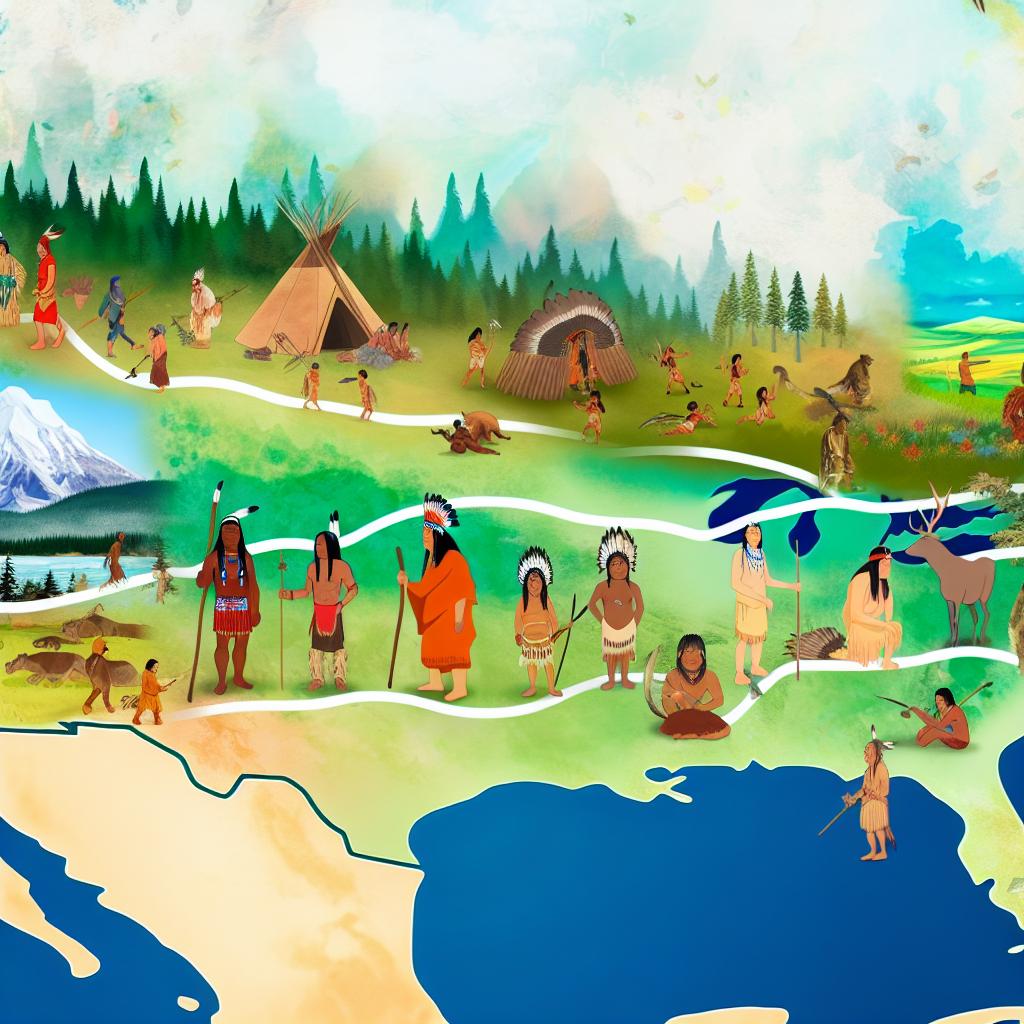The Origins of Native American Peoples
The history of Native American peoples is one of deep antiquity and complex origins, marked by a journey that transcends mere geography. Spanning tens of thousands of years, their story is a blend of migration, adaptation, and cultural evolution. As we strive to understand the depth of this journey, ongoing research and discoveries continue to shed light on their origins and evolution. Here, we explore this narrative through the lenses of migration theories, archaeological discoveries, cultural diversification, and contemporary research.
Initial Migration and Settlement
The prevailing consensus regarding the origins of Native Americans centers around the migration hypothesis, which suggests a gradual movement of people from Asia into North America. This migration is estimated to have occurred during the last Ice Age, a period marked by substantial geological changes that created a link between these two continents.
During this time, known as the Pleistocene Epoch, massive ice sheets covered significant portions of the Northern Hemisphere. This glaciation resulted in lower sea levels, exposing a land bridge commonly referred to as Beringia. Situated between what is now Siberia and Alaska, this land bridge expanded over thousands of kilometers, providing a passageway for human groups. The movement across Beringia is believed to have happened around 15,000 to 20,000 years ago, although some theories push this timeline back even further.
Archaeological and Genetic Evidence
The migration theory is substantiated by an array of archaeological evidence. Various sites across North America have yielded artifacts and tools that trace back to these early populations. Among these, the Clovis culture stands out as one of the most studied groups. Identified by their characteristic stone tools—particularly pointed spearheads known as Clovis points—these artifacts have been unearthed in numerous locations across the continent, dating back roughly 13,000 years.
Yet the story is more than what is written in stone. Advances in genetics have fortified these archaeological findings with biological evidence. Genetic research involves the study of markers present in modern Native American populations. These markers are akin to historical breadcrumbs, tracing lineage back to ancient Siberian groups. Mitochondrial DNA, passed down through generations, provides a compact genetic history. Studies have shown significant similarities between Native American genetic markers and those found in certain Asian populations, supporting the theory of migration across Beringia.
Cultural Diversification and Adaptation
Upon settling across the vast expanse of North America, these early groups demonstrated incredible adaptability. This adaptability is seen in the development of numerous distinct cultures and societies, each forged by the unique environments they inhabited. From the Arctic tundra, dominated by cold climates, to the lush temperate forests and the expansive prairies, every region offered its own set of challenges and opportunities.
The survival and flourishing of Native American societies were deeply tied to their environment. For instance, the Inuit peoples in the northern reaches adapted to the icy landscapes by mastering skills related to hunting marine life and building structures like igloos. Meanwhile, the agricultural ingenuity of groups like the Puebloans, Ancestral Puebloans—or Anasazi—in the arid southwest is epitomized by their cliff dwellings and complex irrigation systems. Across the deserts, plains, coastal areas, and woodlands, the stories of adaptation continue to unfold.
Over millennia, these diverse societies developed intricate belief systems, languages, and traditions, resulting in a rich cultural heritage that offers a glimpse into the societal structures and spiritual frameworks that governed their lives. The vibrant tapestry of Native American culture, evident today, is an amalgamation of these historical developments, characterized by resilience, innovation, and deep connections to the land.
Contemporary Perspectives and Research
In the present era, research concerning Native American origins remains a dynamic and evolving field. Modern technological tools and methodologies have revolutionized this domain especially with the advent of advanced DNA sequencing and ancient DNA analysis. These technologies allow scientists to trace migration patterns with greater accuracy and define timelines that were once speculative.
Moreover, interdisciplinary approaches that combine genetics, archaeology, anthropology, and even linguistics are providing a fuller picture of how these ancient peoples lived and migrated. For example, linguistics can examine the evolution and spread of languages, offering clues about past societies’ connections and movements.
Research initiatives also aim to deconstruct previous misconceptions and assumptions. These include more nuanced considerations of the interactions between different Native groups and the possible repeated migrations that may have occurred over time, revealing a more complex history than a single migration event.
For those keen to explore further, extensive studies and resources are available. Institutions such as museums and academic research centers continue to delve into the origins of Native American peoples. These initiatives contribute to our understanding by unraveling the intricate narratives of human migration and culture that define the history of Native America.
In conclusion, the investigation into the origins of Native American peoples is a rich tapestry woven with threads from various scientific disciplines. It is a narrative that not only enhances our comprehension of human migration but also underscores the enduring legacy and remarkable contributions of Native American communities to the historical timeline. As research advances, new revelations will undoubtedly surface, promising to enrich our appreciation for these ancient people further, revealing the vibrant cultures and adaptive spirits that have characterized their existence throughout history.

